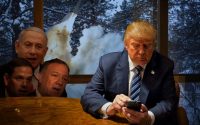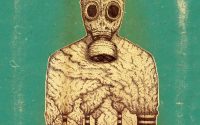Bolivia // A perfectly mundane coup d’état~ 14 min

It’s impossible not to see the black comedy that suffuses the background scenario of the latest coup promoted by the United States of America. The plan is so typical that it could almost be a diagram.
Supporting the latifundio and extractivist bourgeoisie, resentful of the impertinence of its inferiors? Check. Creation of right-wing paramilitary groups to suppress left organizations? Also check. “Exchange” programs targeting military and police officials that later become turncoats? Smear campaign in the capital controlled media? Fawning over and cleaning the image of fascists? Promoting national balkanization? Descendants of Nazis that escaped justice in post-WW2? Check on all of the above.
Eternal resentment
Our story begins with “the dark side of Bolivia’s half-moon”, as nicknamed by journalist Benjamin Dangl. This half-moon encompasses most of the states at lower altitudes, where the agricultural and gas wealth of the country is concentrated.

Historically, its in this half-moon, especially in the Santa Cruz department, that the national bourgeoisie, descendant of colonizers, metastasized. The region is responsible for about 28% of national GDP, neck to neck with the capital. And its bastion is the city of Santa Cruz de la Sierra.
As is to be expected of such ingredients, separatism is a living force. Nothing would be more pleasing to the Bolivian bourgeoisie than setting off dynamite along the mountain border and let the entire burdensome southwest of the country, full of indigenous people that insist on voting wrong, slide into the Pacific.
Lacking the capacity to do so, they constantly fight for greater autonomy from the central government in order to shield themselves from unwelcome things such as redistributive fiscal policies, while striving to return to power.
As soon as Evo Morales was elected, the forces of national and international capital began planning his fall. The United States, under the second administration of Bush Jr., sent over Philip Goldberg to serve as the Bolivian ambassador. He had been previously stationed to oversee the dismemberment of the former Yugoslavia. A mere three months after he arrives, separatist political pressure intensifies, street violence included.
A referendum to gain greater departmental autonomy from the central government wins in four provinces: Pando, Beni, Santa Cruz and Tarija. The separatist plans also included securing the Cochabamba region, under the control of governor Manfred Reyes Villa, but they lose the vote.
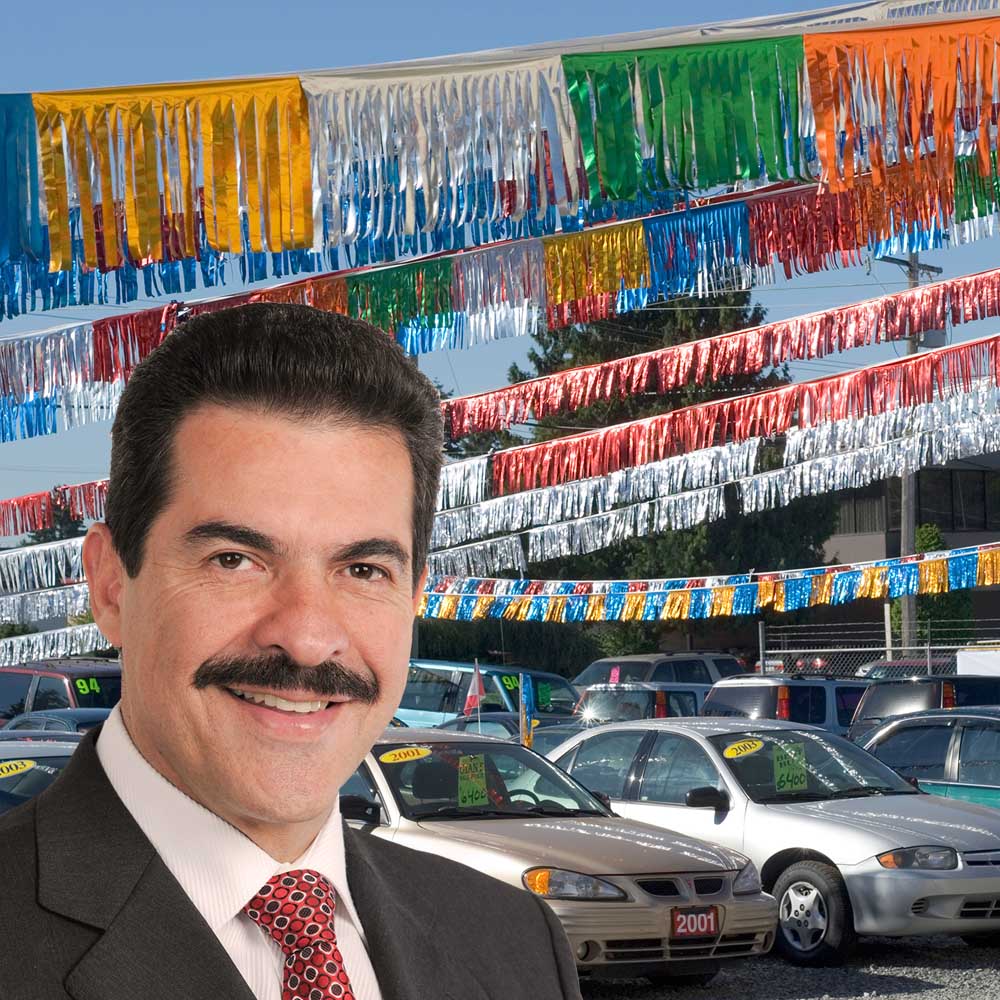
The governor was a good friend of the North-American ambassador, as well as former military, having frequented the “School of the Americas” in 1976, the US organization which can only be described as a training camp for coup plotters and torturers for export to South America. He organized street violence using gangs of privileged youth that beat up and terrorize opponents of separatism, with the support of an organization called “Santa Cruz Youth Union” (Unión Juvenil Cruceñista, or UJC).
The final tally is two dead and 120 seriously wounded, mostly indigenous farmers. To no avail; massive demonstrations force the governor’s resignation. Years later he will exile himself in the US, on the run from a prosecution for illicit enrichment. The American ambassador is also expelled in 2008, for his role in promoting separatism.
For now let us leave Manfred in exile; he will have an important role further ahead.
The heart of the beast
What about that organization that supported the street violence of Cochabamba’s privileged youth, the Santa Cruz Youth Union?
In Santa Cruz de la Sierra, an organization by the name of Pro-Santa Cruz Civic Committee houses the conspiracies of the resentful Bolivian bourgeoisie.

This Committee has long promoted calls for military disobedience against the government and it keeps the police, judicial and media apparatus of Santa Cruz under its control. When Morales paid the city an unannounced visit in 2006, he had to run away under a hail of stones.
The Santa Cruz Youth Union is its armed wing. It’s composed of the sons, sorcerer’s apprentices and miscellaneous rough sorts under the thumb of the Santa Cruz bourgeoisie. Anti-communists with a slight tendency to perform the Nazi salute and all the usual baggage of such organizations like Christian fanaticism along with virulent racism and homophobia. Even the US diplomatic corps recognizes as much in its cables. The UJC is called into action whenever there is a need to beat up, sometimes kill, indigenous people, union organizers, activists, members of the “wrong” party and critical journalists, or stone and burn their offices.
Dark comedy makes another appearance when reading some of the reports about this group of good boys:
When I asked about the meaning of the cross on Unión Juvenil‘s banner, Zurita told me, “It’s not a Nazi symbol.” I told him that I hadn’t asked if it was a Nazi symbol. They were already on the defensive. “We aren’t racist,” he said.
The connections between the two organizations are close, despite denials. If the Committee was a party, the Union would be its youth wing. It’s common for members of the Union to be promoted to members of the Committee when they stand out or become too old to continue as members of the former. The headquarters of the two organizations are literally in front of each other on the same street.
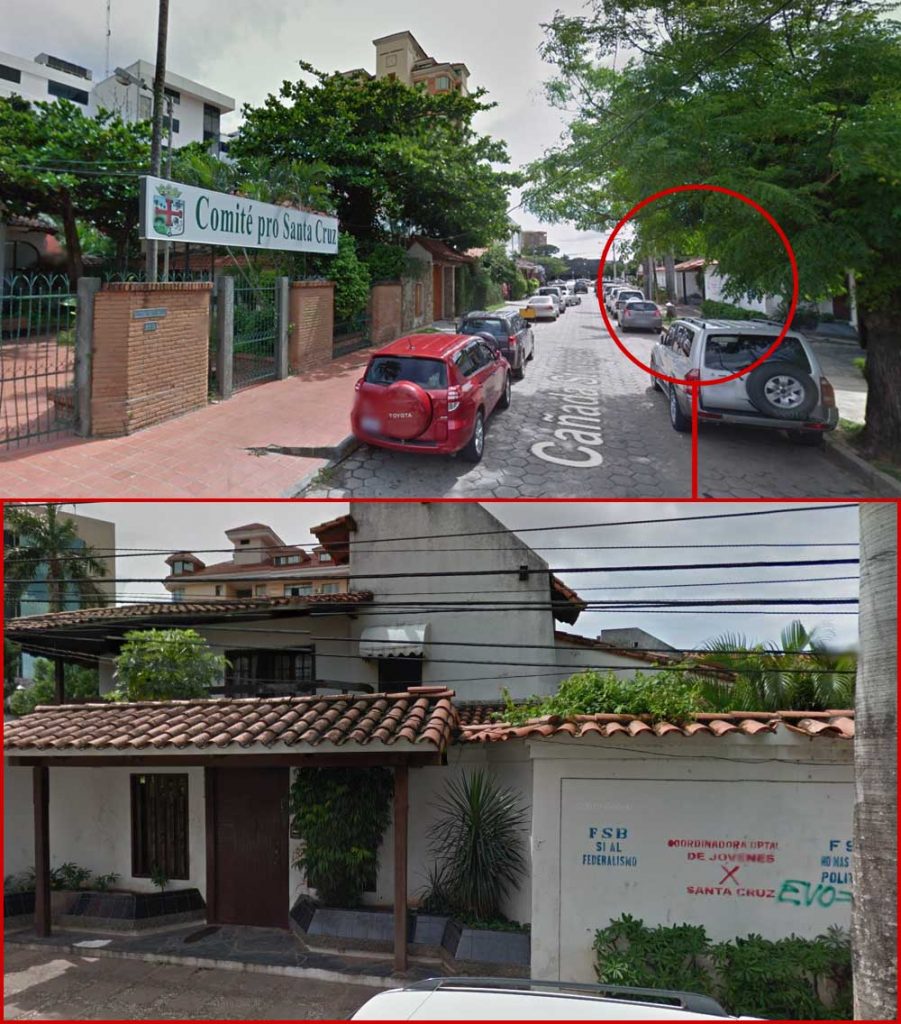
It’s out of these organizations that the face of the coup, Luís Fernando Camacho, comes from. The politician that wants to purge the State of all Morales supporters and “return God to the Quemado Palace”. Camacho is a multimillionaire from a well-to-do family that made its money on the gas business. They were affected by the redistributive policies of Morales, which meant less money from extractivism finding its way into their pockets. He is also named in the Panama Papers as an offshoring facilitator.
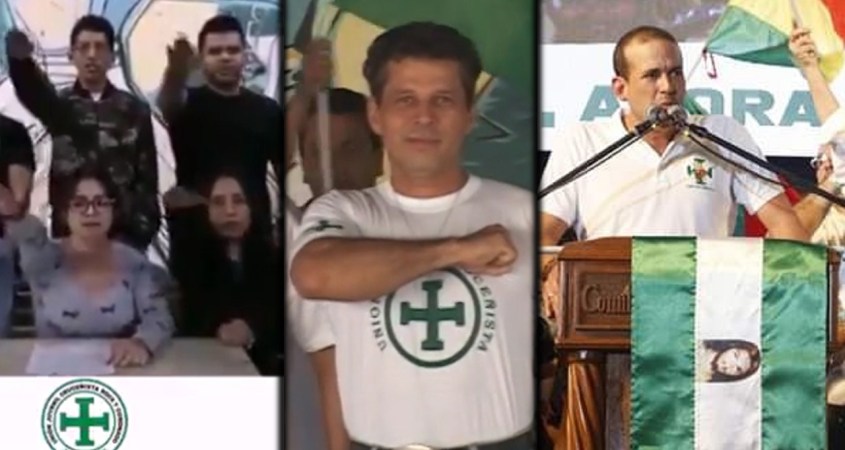
He was the vice-president of UJC between 2002 and 2004, and was later promoted to the Committee. His patron in the organization was Branko Marinkovic, a latifundio businessman of Croatian descent, which became the leader of the Committee in 2007. If you are considering the possibility that Branko lost land to Morales’ policies and became pissy over it… goes without saying: you are correct.
There are rumors that his family was one of those that ran to South America after, I dunno, having belonged to Nazi collaborationist organizations and being on the run from the justice owed to them. Bolivia has a history of such things: Cochabamba was the home of Klaus Barbie, Nazi war criminal who was saved by the North-Americans from being gifted a rope around his neck by the French.
In 2008, Branko is the protagonist of another accidental comedy moment of the Bolivian right when he complains of political persecution to the International Federation for Human Rights. The reply is an open letter exposing the many crimes of the Committee and the Union.
In 2009, Branko is accused of supplying 200 000 dollars to facilitate an assassination attempt against Morales by Irish right-wing mercenaries. He elopes, first to the US, later to Brazil. Where he became, needless to say, a Bolsonaro supporter. Even when arranging the murder of political leaders, the Bolivian opposition finds a way to inject comedy into the proceedings:
The money was given to Argentine gun dealers who disappeared with it without providing weapons, according to one of the other witnesses (…)
If the Bolivian right is such a collection of buffoons, what explains the fact that they finally found success, 13 years after beginning their efforts?
The American touch
One of the advantages of being a super-power with unlimited resources is that you can afford the luxury of being patient with your coup investments. The US invests decades and billions of dollars into building webs of influence which can be activated at key moments such as these.
The US had already generously provided tens to hundreds of millions of dollars back in 2002 to the separatist opposition and its organizations, such as the Pro-Santa Cruz Civic Committee, via its pseudo-humanitarian State agencies funded by the national budget, such as USAID and NED.
Part of the same complex as USAID and NED, the NDI also made the kind gesture of paying for UJC members’ trips to the US, so that they might receive training in carrying out color revolutions.
These same organizations aren’t just used to promote the opposition, but also to fragment the government’s social support base by handing out cash to individuals predisposed to be critical of or oppositional to their former allies, for the right price; or to amplify resentments between different indigenous communities. Benjamin Dangl provided another good example of dark comedy when reporting on his encounter with a “good example” of USAID’s work in Bolivia, recommended by the agency itself:
They put me in touch with Wilma Rocha, the boss at a clothing factory in El Alto called Club de Madres Nueva Esperanza (Mothers’ Club of New Hope). A USAID consultant worked in the factory in 2005-2006, offering advice on management issues and facilitating the export of the business’s clothing to U.S. markets. In a city of well-organized, working class radicals, Rocha is one of the few rightwingers. She is a fierce critic of the Morales administration and the El Alto unions and neighborhood councils.
Ten female employees are knitting at a table in the corner of a vast pink factory room full of dozens of empty sewing machines. “For three months we’ve barely had any work at all,” one of the women explains while Rocha waits at a distance. “When we do get paychecks, the pay is horrible.” I ask for her name, but she says she can’t give it to me. “If the boss finds out we are being critical, she’ll beat us.”
But where the US investment pays the greatest dividends is in the army and police. Seven of the military coup leaders were former students of the School of the Americas, including Williams Kaliman, the general which “invited” president Morales to resign; he also served as the military attaché for the Bolivian embassy in Washington. Several of the police officers that mutinied, such as their general commander, Vladimir Yuri Calderón Mariscal, also frequented APALA (a sort of School of the Americas for police) training courses in Washington, payed for and promoted by the US.
Its in these constant “training” and diplomacy events that the US approaches and forms closes relationships with possible allies, willing to serve the empire when the time comes, in return for 30 pieces of silver. In fact, some seem to have enjoyed the experience so much that they can’t even bring themselves to part with their merch, even on the day of the coup.
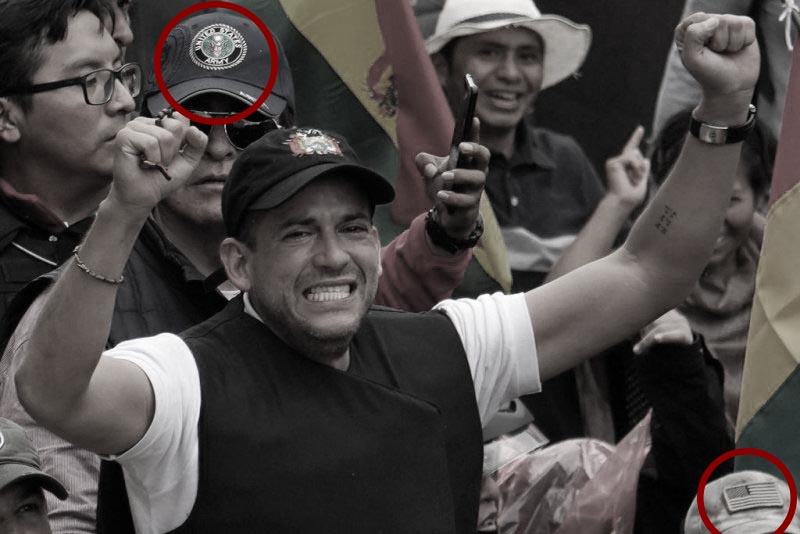
And who returns at this critical hour? Our good friend and exiled governor of Cochabamba, Manfred Reyes Villa, in a heartwarming reunion of old and new students of the SOA, in order to plot the government’s downfall. In a series of leaked audios, the members of the conspiracy can be heard discussing different plans, such as burning down government buildings, having yellow unions go on strike and harassing MAS (Morales’ party) members. Soon, all those plans and many others would be set into motion.
They also discuss how they count on the support of the evangelical community, along with Colombia and Brazil and US senators Ted Cruz, Bob Menéndez and Marco Rubio. Coincidences: all three senators are gusanos. Camacho was also busy. Months before the coup, he did a South America tour to court the support of Colombia, Brazil and of the self-proclaimed government in “exile” of Juan Guaidó.
Both Manfred Reyes Villa and Branko Marinkovic are now pondering a return to Bolivia, dependent on the implementation by the new government of an amnesty regarding the crimes previously committed by these enterprising individuals.
The trumpeters
Without a good public relations service working for the “democratic opposition”, this entire process would look too transparent. The capital controlled media was more than happy to provide it.
That’s how a second rate figure that no one had ever heard of like Juan Guaidó was taken seriously as the self-proclaimed president of Venezuela. Similarly to how a nobody called Luís Fernando Camacho, who had never been elected to any political office, was transformed overnight into the leader of the coup for democracy and freedom in Bolivia.
They are carried on the shoulders of the big Spanish speaking media like Unitel, Telemundo and CNN Español. In English language media, the coup leader was described like this:
(…) a “conservative protest leader” (BBC, 11/13/19), “a firebrand Christian” (Financial Times, 11/12/19) and a “civic leader” (Reuters, 11/7/19).
Besides helping propagate the electoral coup narrative, the right-wing street violence is also sanitized:
(…) “mass protests” (BBC, 10/31/19), “dissent” (AP, 11/8/19) and “civil disobedience” (New York Times, 10/31/19).
The right-wing violence was framed as “clashes” (DW, 11/8/19; France 24, 11/8/19) over “controversial” or “disputed” electoral results (Washington Post, 11/07/19; BBC, 11/7/19) (…)
Over at Twitter, Camacho’s account, unknown to the world until recently, jumps from 2000 followers to 130 000 in a mere week. Over 50 000 of these accounts had been created in the last two weeks of November. A mad Twitter rush in a country where the platform represents less than 3% of social media usage. And even if that wasn’t the case, it would be irrelevant. The true importance of these campaigns is in influencing the journalists that proliferate on Twitter, anxiously awaiting Trump’s next tweet, and thus influencing their respective audiences all over the world.
During the following days, a message obsessively repeats itself through these accounts: “Friends from everywhere, in Bolivia there was no coup”. One of the activity hubs for this operation is the state of Virginia, in the US – home of the CIA.
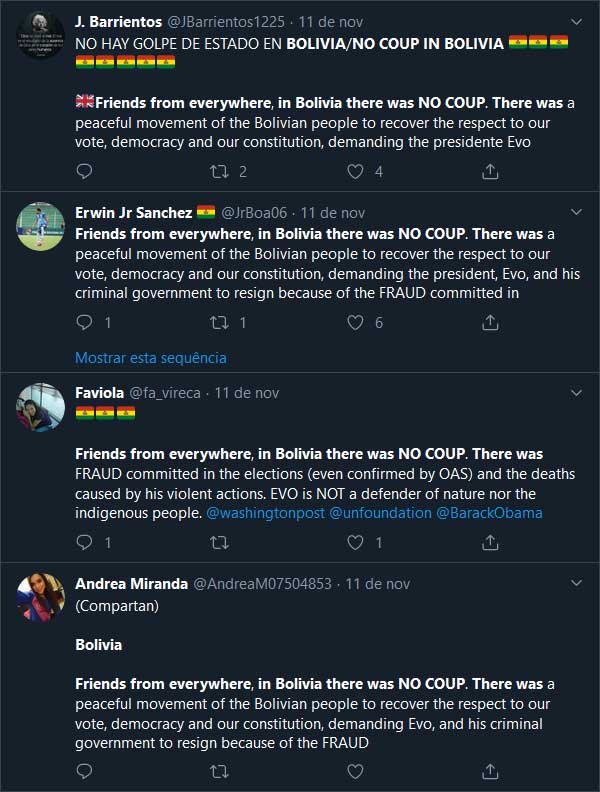
I don’t know about you all, but I’m convinced.

